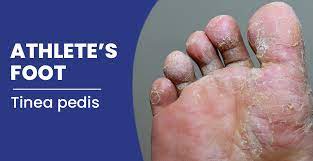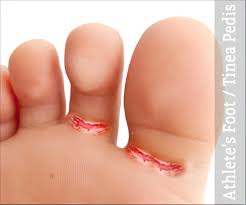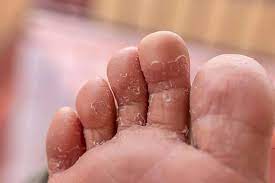Athlete’s Foot Treatment

Our bodies are prone to several types of conditions, caused by pathogenic material. Oftentimes, our body's immunity works tirelessly to protect us, and often they succeed. On some occasions, however, the pathogen overcomes the body's defence mechanisms and causes infections and diseases. Some of the most common types of pathogens are viruses, bacteria and fungi. Fungi infections are common, affecting commonly-used parts, such as the feet. One of the most popular fungal infections is the athlete’s foot, which affects the feet.
Athlete’s foot is a fungal infection, that mostly affects the feet. It is also called Tinea Pedis (foot ringworm). It is caused by the Tinea fungi, a type of fungi that grows on the skin. The Tinea fungi is a type of ringworm. It mostly affects the feet, especially the areas between the toes. If untreated, it can spread over to the toenails, the top of the toe, the soles of the feet and also the heels. Furthermore, it can also affect the hands. It makes your skin in affected areas appear irritated, scaly and flaky. It can also cause cracked skin and blisters that are pus filled at times. In some cases, the affected areas may be itchy and uncomfortable. Moreover, it can also cause feet odour.

Athletes’ foot is the most common type of fungal infection. Studies show that an estimated 3% to 15% of the world’s population has athlete’s foot. From an eyes view, this might seem like a small number, but it represents between 250 million to over 1.2 billion people all over the world. Furthermore, an estimated 70% of the population may get infected with this infection at some point in life. Athletes’ foot is contagious and can be passed from one person to another. You can get the infection by getting into contact with infected surfaces, or material of an infected person. Most people get this infection from swimming pools, gyms or locker rooms, saunas other places used by large groups of people.
Athlete’s foot is called so since it is most often found in athletes. It can however affect anyone, regardless of their age, gender or ethnicity. Nevertheless, it mostly affects men more than it does women. People over the age of 60 are also at greater risk of getting infected. Furthermore, people with diabetes, obese individuals and people with weakened immune systems are also at higher risk of getting Athlete’s foot. Having tissue damage or wounds on your feet can also increase your chances of getting infected.
Symptoms
Symptoms of athlete’s foot include:
- Peeling, cracking and scaling of the feet
- Redness, blisters or softening of the skin
- Itching and/or burning of the skin
- Feet odour

However, these symptoms vary depending on the type of Athlete’s foot one has. These types are:
Toe-web infections- It’s the most common type of Athlete’s foot. It typically affects the skin between your fourth and fifth toes. It causes flaking, peeling and changes in the colour of the skin.
Moccasin-type infection- It mostly affects the bottom of the feet, your heel and the edges of your feet. It causes soreness in the infected area for some days. Moreover, it causes thickening and consequent skin cracking underneath your feet. It can also affect the toenails, making them thicker and weaker. The toenails break into small pieces and fall out.
Vesicular type infections- It affects the bottom of the feet but can appear on any spot of the feet. It usually causes bumps and blisters, which contain pus-like fluid. These blisters are also prone to bacterial infections, and one may contract an easy infection.
Ulcerative infections- are very rare. Characterised by the appearance of open sores(ulcers) between the toes. These ulcers may also appear at the bottom of the feet.
Athlete’s foot does not go away on its own. It needs medical intervention to aid in its treatment. If left untreated, the condition spreads to other parts of the body such as your nails, hands and groin. This often occurs when one uses a towel to wipe their infected feet and uses the same towel for other body parts. When the infection affects the groin, it leads to a condition called jock itch. Athletes’ feet are treatable, but one should seek qualified medics to diagnose and recommend treatment for the condition. Self-diagnosis can be dangerous since it leads to buying of over-the-counter products, some of which may be dangerous. Others might even aggravate the infections if not well used.
Diagnosis
Before one you get any form of treatment, it is important that you seek medical diagnosis, from a reputable medical centre or qualified medics. At Avané clinic, we offer just this. We have a team of qualified, certified ad learned medics with years of experience in the medical field. The doctors will be able to diagnose athlete’s foot by examining your feet and reviewing your symptoms. Furthermore, they will conduct a biopsy test to examine and identify the exact type of fungal infection you have, the doctor also reviews your medical history and past conditions. Inform the doctor of any allergies or any other information that he might request, to aid in diagnosis and treatment.
Treatment.
Treatment of athlete’s foot is depending on the type and severity of the infection. It is mostly done by using antifungal medications. They help kill the fungus or slow down the infection. The doctors will prescribe antifungal creams, ointments, gels, sprays or powders effectively treat athlete’s foot. These products contain clotrimazole, miconazole, tolnaftate or terbinafine. Some prescription antifungal medications are pills. These pills contain fluconazole, itraconazole or terbinafine. It’s important to finish your full dosage of medicine. If you stop too soon, your athlete’s foot may come back and be harder to treat. You can also use it for an additional 2 weeks after the infection has healed. This helps prevent reinfection or reoccurrence of the athlete’s foot.
Prevention and home care treatment.
There is a common saying that prevention s better than cure. Prevention of athlete’s foot is also very important since it saves you lots of trouble and medical expenses. You can take safety precautions to prevent athlete’s foot, these include:
- Keep your feet clean and dry, especially between your toes.
- Wash your feet thoroughly with soap and water and dry the area carefully and completely. Try to do this at least twice a day.
- To widen and keep the web space (area between the toes) dry, use lamb's wool. This can be bought at a drugstore.
- Wear clean cotton socks. Change your socks and shoes as often as needed to keep your feet dry.
- Wear sandals or flip-flops at a public shower or pool.
- Use antifungal or drying powders to prevent athlete's foot if you tend to get it often, or your frequent places where athlete's foot fungus is common (like public showers).
- Wear shoes that are well-ventilated and made of natural materials such as leather.
- It may help to alternate shoes each day, so they can completely dry between wearing.
- Do not wear plastic-lined shoes.
Take Away.
Athlete’s foot may not be a deadly skin condition, but the inconvenience it can cause is major. It leads to flaking and cracking of the skin, itchiness and pain which might be uncomfortable. Moreover, its effects surpass just the physical effects but also take a toll on your psychological and social well-being. It causes foot odour, which can affect your social life and make you feel self-conscious and lower your self-esteem. Finding the right treatment is important, and that’s why at Avané clinic, we are offering you the best Athlete’s foot treatment. We are located at the Yaya centre, in Nairobi Kenya. Visit us today for consultation and treatment or contact us to book your appointment today.






Leave a Reply